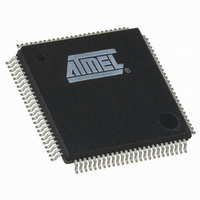ATSAM3S4CA-AU Atmel, ATSAM3S4CA-AU Datasheet - Page 941

ATSAM3S4CA-AU
Manufacturer Part Number
ATSAM3S4CA-AU
Description
IC MCU 32BIT 256KB FLASH 100LQFP
Manufacturer
Atmel
Series
SAM3Sr
Specifications of ATSAM3S4CA-AU
Core Processor
ARM® Cortex-M3™
Core Size
32-Bit
Speed
64MHz
Connectivity
EBI/EMI, I²C, MMC, SPI, SSC, UART/USART, USB
Peripherals
Brown-out Detect/Reset, DMA, I²S, POR, PWM, WDT
Number Of I /o
79
Program Memory Size
256KB (256K x 8)
Program Memory Type
FLASH
Ram Size
48K x 8
Voltage - Supply (vcc/vdd)
1.62 V ~ 1.95 V
Data Converters
A/D 16x10/12b, D/A 2x12b
Oscillator Type
Internal
Operating Temperature
-40°C ~ 85°C
Package / Case
100-LQFP
Controller Family/series
ATSAM3S
No. Of I/o's
79
Ram Memory Size
48KB
Cpu Speed
64MHz
No. Of Timers
6
Rohs Compliant
Yes
Processor Series
ATSAM3x
Core
ARM Cortex M3
3rd Party Development Tools
JTRACE-CM3, MDK-ARM, RL-ARM, ULINK2
Development Tools By Supplier
ATSAM3S-EK
Cpu Family
AT91
Device Core
ARM Cortex-M3
Device Core Size
32b
Frequency (max)
64MHz
Total Internal Ram Size
48KB
# I/os (max)
79
Number Of Timers - General Purpose
6
Operating Supply Voltage (typ)
1.8/3.3V
Operating Supply Voltage (max)
1.95/3.6V
Operating Supply Voltage (min)
1.62V
On-chip Adc
16-chx12-bit
On-chip Dac
2-chx12-bit
Instruction Set Architecture
RISC
Operating Temp Range
-40C to 85C
Operating Temperature Classification
Industrial
Mounting
Surface Mount
Pin Count
100
Package Type
LQFP
Lead Free Status / RoHS Status
Lead free / RoHS Compliant
Eeprom Size
-
Lead Free Status / Rohs Status
Details
Available stocks
Company
Part Number
Manufacturer
Quantity
Price
Part Number:
ATSAM3S4CA-AU
Manufacturer:
ATMEL/爱特梅尔
Quantity:
20 000
- Current page: 941 of 1118
- Download datasheet (24Mb)
37.6.3.1
37.6.3.2
37.6.3.3
37.6.3.4
37.6.3.5
6500C–ATARM–8-Feb-11
Not Powered State
Entering Attached State
From Powered State to Default State
From Default State to Address State
From Address State to Configured State
Self powered devices can detect 5V VBUS using a PIO as described in the typical connection
section. When the device is not connected to a host, device power consumption can be reduced
by disabling MCK for the UDP, disabling UDPCK and disabling the transceiver. DDP and DDM
lines are pulled down by 330 KΩ resistors.
To enable integrated pull-up, the PUON bit in the UDP_TXVC register must be set.
Warning: To write to the UDP_TXVC register, MCK clock must be enabled on the UDP. This is
done in the Power Management Controller.
After pull-up connection, the device enters the powered state. In this state, the UDPCK and
MCK must be enabled in the Power Management Controller. The transceiver can remain
disabled.
After its connection to a USB host, the USB device waits for an end-of-bus reset. The unmask-
able flag ENDBUSRES is set in the register UDP_ISR and an interrupt is triggered.
Once the ENDBUSRES interrupt has been triggered, the device enters Default State. In this
state, the UDP software must:
In this state UDPCK and MCK must be enabled.
Warning: Each time an ENDBUSRES interrupt is triggered, the Interrupt Mask Register and
UDP_CSR registers have been reset.
After a set address standard device request, the USB host peripheral enters the address state.
Warning: Before the device enters in address state, it must achieve the Status IN transaction of
the control transfer, i.e., the UDP device sets its new address once the TXCOMP flag in the
UDP_CSR[0] register has been received and cleared.
To move to address state, the driver software sets the FADDEN flag in the UDP_GLB_STAT
register, sets its new address, and sets the FEN bit in the UDP_FADDR register.
Once a valid Set Configuration standard request has been received and acknowledged, the
device enables endpoints corresponding to the current configuration. This is done by setting the
EPEDS and EPTYPE fields in the UDP_CSRx registers and, optionally, enabling corresponding
interrupts in the UDP_IER register.
• Enable the default endpoint, setting the EPEDS flag in the UDP_CSR[0] register and,
• Configure the interrupt mask register which has been reset by the USB reset detection
• Enable the transceiver clearing the TXVDIS flag in the UDP_TXVC register.
optionally, enabling the interrupt for endpoint 0 by writing 1 to the UDP_IER register. The
enumeration then begins by a control transfer.
SAM3S Preliminary
941
Related parts for ATSAM3S4CA-AU
Image
Part Number
Description
Manufacturer
Datasheet
Request
R

Part Number:
Description:
KIT EVAL FOR ATSAM3S4C
Manufacturer:
Atmel
Datasheet:

Part Number:
Description:
Development Boards & Kits - ARM EVAL KIT SAM3S8 & SAM3SD8 series
Manufacturer:
Atmel
Datasheet:

Part Number:
Description:
AT91 ARM Cortex M3-based Processor
Manufacturer:
ATMEL [ATMEL Corporation]
Datasheet:

Part Number:
Description:
DEV KIT FOR AVR/AVR32
Manufacturer:
Atmel
Datasheet:

Part Number:
Description:
INTERVAL AND WIPE/WASH WIPER CONTROL IC WITH DELAY
Manufacturer:
ATMEL Corporation
Datasheet:

Part Number:
Description:
Low-Voltage Voice-Switched IC for Hands-Free Operation
Manufacturer:
ATMEL Corporation
Datasheet:

Part Number:
Description:
MONOLITHIC INTEGRATED FEATUREPHONE CIRCUIT
Manufacturer:
ATMEL Corporation
Datasheet:

Part Number:
Description:
AM-FM Receiver IC U4255BM-M
Manufacturer:
ATMEL Corporation
Datasheet:

Part Number:
Description:
Monolithic Integrated Feature Phone Circuit
Manufacturer:
ATMEL Corporation
Datasheet:

Part Number:
Description:
Multistandard Video-IF and Quasi Parallel Sound Processing
Manufacturer:
ATMEL Corporation
Datasheet:

Part Number:
Description:
High-performance EE PLD
Manufacturer:
ATMEL Corporation
Datasheet:

Part Number:
Description:
8-bit Flash Microcontroller
Manufacturer:
ATMEL Corporation
Datasheet:











